Zero Returns & Climate Change Leaves Women Farmers Tired And Broke
Oct 24, 2025 | Pratirodh Bureau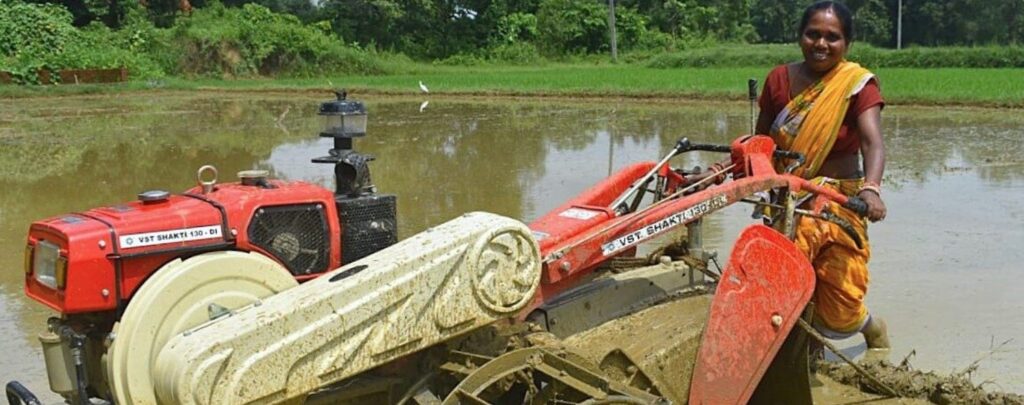
Mechanised farming equipment such as drum seeders, mechanical weeders, and reapers reduce physical effort and time in the field (Image by IRRI)
- Women undertake most of the menial labour in traditional paddy cultivation, bearing the brunt of climate change while also unwittingly contributing to emissions.
- Studies highlight that women paddy farmers suffer physical and mental health issues from increased exposure to weather extremes, and have little capacity to withstand the income loss from it.
- Systemic responses such as training and adoption of climate-smart practices, access to credit and machinery, ensuring support by agriculture extension officers and more can help them adapt.
Generations of women in Sampreetha’s family have worked on their rice fields. During the COVID-19 lockdown, Sampreetha, who goes by her first name, was pursuing a Master’s degree in agriculture. When her college closed, she returned home to Sakleshpur, Karnataka, and began helping on the family’s six-acre farm. She soon realised that paddy cultivation involved a chain of menial, labour-intensive tasks, most of them carried out by women.
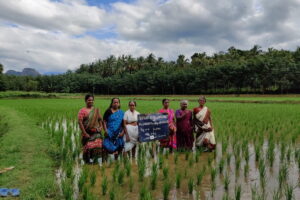
Women farmers may not be familiar with the term “climate change”, but they constantly feel its effects on their bodies and in their pockets, she observes. “They don’t know the words ‘adaptation’ or ‘mitigation’. But they say, ‘it didn’t feel like this 10 years ago. Earlier, the rains came in June or July, but now they are late,’” Sampreetha says.
Paddy cultivation supplies half the global population with staple food, but also accounts for 48% of greenhouse gas (GHG) emissions from croplands.
However, many call these “survival” emissions as they provide livelihood to millions of farmers across economies. India refused to sign the Global Methane Pledge at COP26 in 2021 held at Glasgow, UK, wherein countries promised a 30% reduction of emissions by 2030, since it threatened the livelihood of the large population of small and marginal farmers. Studies, however, show that these farmers are also now suffering because of climate change. With every 1°C rise in temperature, paddy yields declined by 10-15% leading to food and income insecurity across the regions, according to the International Rice Research Institute (IRRI).
Women farmers on the frontline
Climate change, combined with the drudgery required for rice cultivation, was severely affecting women farmers’ well-being, explains Dhanya Punnoli, an independent researcher formerly with the Government College, Chittur in Kerala.
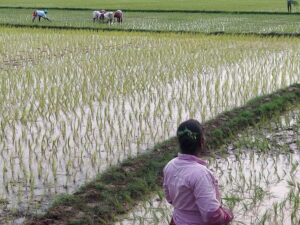
Punnoli studied women rice farmers from Palakkad district, the rice granary of Kerala, to understand on-ground and year-round effects of climate change. In the chapter “Assessment of Women Farmers’ Drudgery in Rice Farming with Climate Change: A Case Study from South India” in Gender-Transformative Approaches for Climate Change Adaptation, published by Springer Climate in 2025, she writes that women farmers were exposed to waterborne diseases, several skin conditions and allergies, dehydration and heat exhaustion, among other health issues associated with rice cultivation. The study, a participatory survey of 135 male and female farmers, also found that difficulties associated with physical labour during the three crop-producing seasons vary.
Out of the 99 female farmers surveyed, 27 said that their health was severely impacted by climate-induced disasters; only six out of the 36 male farmers responded that they were severely impacted by climate-related challenges in rice farming. When temperatures soared, health problems like severe skin damage, irritation, and itching were reported by the farmers. Dehydration-related illnesses were common, followed by heat boils and prickly heat rashes. The least impacted people were either having high adaptive capacity — they had better economic status and living standards, higher educational qualifications, or less sensitivity and exposure to impacts, such as working on farms located away from flood-prone areas.
“When we say ‘farmer,’ we imagine a man. But rice cultivation is mostly done by women,” Sampreetha explains. Transplanting, where young rice seedlings are moved from a nursery to a main field to ensure a uniform and established crop, is back-breaking work largely done by women.
A 2020 study published in Springer Nature calculates that women contributed 60% of the work in manually transplanting India’s 44 million hectares of rice farmland, which amounts to 814 million labour days. A study from Odisha shows that rice transplanting and associated activities account for around 22% of the total time spent by women family members and 46% of women wage labourers. Sudhanshu Singh, Director, IRRI South Asia Regional Centre, points out: “Across South Asia, women carry out most of the labour-intensive operations in rice farming, such as transplanting, weeding, harvesting, threshing, winnowing, and grain or seed processing. With rising temperatures, unpredictable rainfall, and longer dry spells, their workload and vulnerability are increasing.”
Year-round impacts on health and economy
Women own only 13.9% of farmland in India, as per the data available in the Agriculture Census. But they constitute over 42% of the agricultural workforce, and in some states, they make up the majority of full-time agricultural workers, according to the Periodic Labour Force Survey 2024.
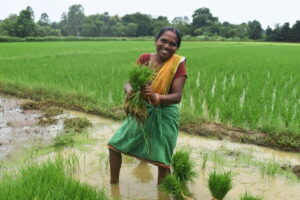
One of the reasons for worsening health and incomes of women rice farmers is that they continue to follow the same cultivation strategies that previous generations did, Sampreetha explains. They could identify the changing patterns of rainfall and increasing heat, but did not have the freedom, resources or capacity to change the way they farm, experts point out.
Women’s agency and land ownership, or lack of it, is one of the biggest factors determining their response to climate change. Since women farmers typically have limited land ownership, decisions regarding irrigation, farm machinery and credit services have to be deferred often to male land owners. Thus, “when climate stress reduces agricultural productivity, women’s capacity to adapt or recover is much lower than that of men,” Singh explains.
In Palakkad, the effects of climate change are no longer confined to a particular season but play out across all three cropping cycles of the year, says Punnoli. The first cropping season usually ends in August or September, but delayed monsoons in June now often force farmers to skip it altogether.
“In the last five or six years, we’ve noticed a kind of mini-summer after this period. Farmers are unable to bear the heat from the high daytime temperatures,” she observes. In 2023, for instance, the Kerala State Disaster Management Authority issued heat advisories as early as August, when temperatures in Palakkad crossed 35°C, followed soon after by bouts of heavy rainfall.
Between 1983 and 2023, Kerala saw an increase in winter and summer rainfall rates even as its overall annual rainfall declined, according to a study published in the Bulletin of Atmospheric Science and Technology (2025). The study found that rainfall patterns are shifting unevenly across the state — some regions are becoming wetter or drier faster than others — highlighting the complex imprint of climate change.
Thunder and lightning have also become frequent disruptions, keeping women farmers away from their fields. Globally, lightning strikes are projected to increase by about 12% with every 1°C rise in average air temperature.
The early onset of summer now overlaps with the second cropping season, compounding heat stress for farm labourers. In 2024, Kerala not only experienced summer in January and February, but also recorded its hottest spell since 1901. “That kind of temperature shift makes farming extremely hard. There are no resting places or water facilities,” Punnoli says. “I’ve seen women carrying water in plastic bags and bottles, something I’d never seen before. They can’t afford bottled water priced at ₹20.”
Yet, these climate impacts are far from uniform across Kerala. “Each region tells a different story: the problems of coastal, saline areas are not the same as those of the drylands. Only when you go into people’s hearts do you begin to understand their local realities,” she says.
Singh from IRRI adds that in eastern India, irregular monsoon patterns often compel farmers to replant crops several times, extending women’s hours in the field, leading to fatigue. In lowland ecologies like northern Bihar and Assam, frequent and recurrent floods destroy crops and erode household food security, the burden of which falls on women. Amid such shocks, women’s unpaid care responsibilities intensify as they cope with food scarcity, fetch water, and tend to their families’ health needs, he notes.
Agency and adaptive capacity
Sampreetha’s research found that not all women are coping well with the worsening climate change. She surveyed the adaptive capacity of 120 women farmers in two Karnataka villages in Shimmoga and Hassan. “Women don’t know of climate-resilient technologies. The agriculture department is lacking in providing training programmes, especially for women farmers,” Sampreetha says.
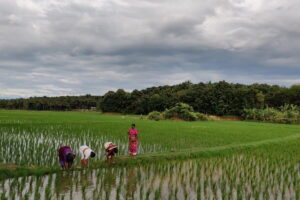
The first step towards adaptation is to “simplify and streamline farming practices, making them more accessible and efficient for women,” according to Singh. Mechanised options such as drum seeders, mechanical weeders, and reapers reduce physical effort and time in the field. Technologies like laser land levelling and Direct Seeded Rice (DSR) improve yields. They not only save water, and reduce emissions, but also ease women’s workload, Singh notes. The 2020 Nature study found that such interventions can reduce emissions by five to 25% depending on the technology adopted, while also reducing the burden on women by 75-90%.
Punnoli suggests that setting up more custom hiring centres — government- or community-run facilities that rent farm machinery and equipment to small and marginal farmers at affordable rates — could help improve access to climate-smart technologies. “Kerala, for instance, doesn’t have such centres. There are so many tools and mechanised solutions developed by ICAR, but they aren’t reaching women farmers,” she explains.
Women farmers also told Sampreetha that they would benefit from more female extension officers and regular training sessions. Singh notes that the IRRI has partnered with state governments and rural federations to build a cadre of women master trainers. “These women receive training on climate-smart and sustainable agricultural practices and then share their knowledge with others in their communities,” he says. Collaborations with Mission Shakti in Odisha and JEEViKA in Bihar have been particularly effective.
Experts add that other interventions, such as digital inclusion, localised early-warning systems, and Agromet Advisories, are helping women farmers adapt to climate extremes.
“The future of resilient agriculture in South Asia depends on how well we empower women,” Singh emphasises. “Their leadership is essential to transforming food systems, improving nutrition, and achieving climate resilience.”
(Published under Creative Commons from Mongabay India)
